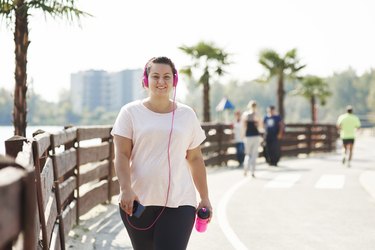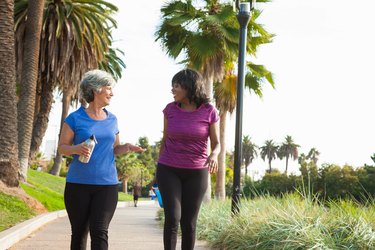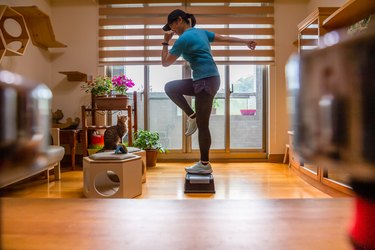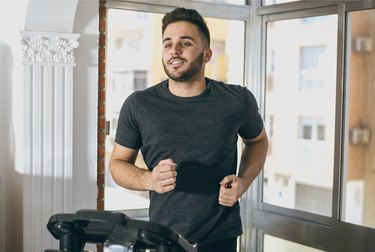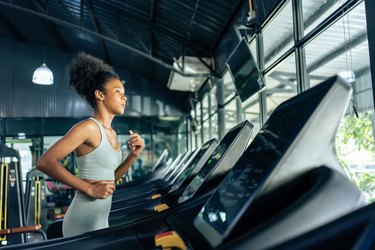

Exercise does all sorts of nifty things for your body. It can help you feel stronger, faster and just better in your day-to-day life. And it may even help your daily trip to the bathroom, too.
In fact, being active and working out has proven to be effective in treating constipation, according to a January 2019 study in the Scandinavian Journal of Gastroenterology. It may even help with alleviating and managing symptoms of irritable bowel syndrome (IBS), per the Mayo Clinic.
Video of the Day
But that doesn't apply to all modalities. Learn which types of workouts can help speed your digestion and which may be harming your regularity.
3 Workouts That May Be Good for Digestion
If you're wondering what specific type of workouts can help with digestion, lower-intensity exercise, such as the following three workouts, generally offer the best benefits, both in the short and long term.
1. Yoga
Because yoga involves bending, folding, arching, stretching and twisting your torso, it can have profound benefits on a your digestion, says Kelly Clifton Turner, registered yoga teacher and director of education at YogaSix.
"All of those actions manipulate your internal organs, including your stomach and intestines, which can help 'move things along,' so to speak," she tells LIVESTRONG.com. "That's one of the many reasons hearing someone break wind in class is not an uncommon occurrence."
Turner recommends these particular poses that can help:
Puppy Pose
- Start in a tabletop position with your hips over your knees and shoulders over your wrists.
- Engage your abdominals by pulling your bellybutton in toward your spine and up toward your ribcage. It should be a gentle drawing in, not a full sucking in of your stomach.
- Walk your hands forward until your arms are outstretched in front of you, allowing your chest to lower between your shoulders.
- Keep your palms flat on the mat and actively press into your hands, keeping your elbows off the floor.
- Look down toward the floor, keeping your neck in line with the rest of your spine and making sure your hips have remained stacked over your knees.
- Stay here for 8 to 10 breaths.
This blend of downward facing dog and child's pose positions your hips as the highest point in your body, “which gives any trapped gas bubbles the perfect path to freedom,” Turner says.
Seated Twist
- Sit up tall with your legs crossed.
- Place your left hand to your right knee and your right hand on the floor behind you as you twist to the right.
- Hold for a few breaths before switching sides.
Twists in yoga are great for promoting digestion because the squeeze followed by the release mimics and amplifies the natural wave-like contractions of your intestinal tract, known as peristalsis, Turner says.
Wind-Relieving Pose
- Lie on your back.
- Draw your left knee into your chest and clasp your hands around your shin (or behind your thigh if you can’t quite reach).
- Stay in this position for a few deep breaths, then switch legs.
This supine (lying on your back) pose can help you get rid of any trapped gas in your abdomen, Turner says.
2. Walking
If you're feeling overstuffed after a meal, a short walk could expedite your trip to the bathroom, according to a groundbreaking March 2008 study from the Journal of Gastrointestinal and Liver Diseases. After comparing the effects of espresso, an alcoholic digestif and walking on digestion, researchers found that walking decreased foods' transit time, while neither beverage helped at all.
Other studies, like a February 2022 meta-analysis in Sports Medicine, have found that even a short walk after a meal helped lower high blood sugar. Unstable blood sugar levels from diabetes can lead to gastroparesis, a condition that keeps food in the stomach too long and causes very high or very low blood sugar, according to the Gastrointestinal Society.
People living with digestive disorders like IBS or constipation can also get some relief from moderate aerobic activity, like walking, according to Patrick B. Wilson, PhD, RD, assistant professor of human movement science at Old Dominion University.
"And as for that 'gotta go' feeling in the colon, motility can actually go up, which may correspond to urges to use the restroom," he says.
3. Running
If you need to go but can't, consider a run, says Carol Aguirre, RD, LDN, a running coach and dietitian. Running at a steady, moderate pace works your intestinal muscles, which helps encourage bowel movements to come more quickly.
Like yoga, running can induce peristalsis (involuntary relaxation of your intestines), which is why many runners are familiar with that 'oh, crap' moment during a run. Aside from those physiological benefits of running, the actual jostling created by a good jog can encourage bowel movements.
"All that movement up and down can agitate the digestive system and leave one the need to find a bathroom ASAP," Aguirre says.
Aguirre cautions, however, that very long runs and very high-intensity sprints may add to gastrointestinal distress, so it's best to stick with a light jog if you're looking to improve digestion.
2 Workouts That Might Actually Slow Digestion
While exercise offers ample benefits, it doesn't universally improve digestion for everyone, Wilson says. Some exercise can pose a challenge to the gut, he says — particularly intense or prolonged sessions.
"In some people, [exercise] can have positive effects," Wilson explains, "while in others, especially those who train very hard and at high volumes, it can actually cause more symptoms."
That's because the release of stress hormones, such as adrenaline, noradrenaline and cortisol, at the onset of exercise shunts blood away from your organs and toward your working muscles.
"The more intense exercise is, the larger this shunting of blood is," he says.
1. High-Intensity Exercise
"Acutely, high-intensity exercise is much more likely than mild exercise to cause symptoms during exercise itself," Wilson says. So if you're dealing with digestive discomfort already, hitting the treadmill for a sprint interval workout or doing a CrossFit workout probably won't help.
The risk of intestinal injury also increases as your exercise intensity goes up, according to a June 2017 study from Alimentary Pharmacology and Therapeutic. So if you have a history of digestive disorders, check in with your doctor about introducing high-intensity exercise into your routine.
2. Heavy Weightlifting
Likewise, lifting very heavy weights or performing very high volume weightlifting (many reps and sets) can perpetuate digestive discomfort, Wilson says. These types of training put a great deal of stress on your body, which can lead to elevated levels of cortisol and poor digestion.
Ultimately, the type of exercise that would best benefit your digestion depends on many factors: genetics, medical history, your goals and your current symptoms. There are many different causes of GI symptoms — irritable bowel diseases, medications, foods, stress and more — so if you consistently experience digestive issues, you should speak with your doctor.
- Scandinavian Journal of Gastroenterology: "Exercise Therapy in Patients With Constipation: A Systematic Review and Meta-Analysis of Randomized Controlled Trials"
- Journal of Gastrointestinal Liver Diseases: "Postprandial Walking But Not Consumption of Alcoholic Digestifs or Espresso Accelerates Gastric Emptying in Healthy Volunteers"
- Diabetes Care: "Three 15-min Bouts of Moderate Postmeal Walking Significantly Improves 24-h Glycemic Control in Older People at Risk for Impaired Glucose Tolerance"
- GI Society: Diabetes and the Gut
- Alimentary Pharmacology and Therapeutics: "Systematic Review: Exercise‐Induced Gastrointestinal Syndrome—Implications for Health and Intestinal Disease"
- Mayo Clinic: "Irritable Bowel Syndrome"
- Sports Medicine: "The Acute Effects of Interrupting Prolonged Sitting Time in Adults with Standing and Light-Intensity Walking on Biomarkers of Cardiometabolic Health in Adults: A Systematic Review and Meta-analysis"
